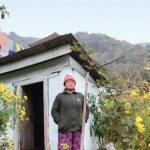By Sayantan Bera –

Thumbs up to Sikkim
Seventy-year-old Lilabati Gautam’s modest wooden house in Ranka block of East Sikkim is better than many posh resorts. Perched on a hill slope, it overlooks orange trees dotting a lush green valley. In one corner is a two-set toilet built with concrete and tin. It receives water straight from a mountain stream. The washroom and latrine set was built a decade ago with half the expenses sponsored by TSC. It also holds a beautiful example of how to ensure sanitation in difficult terrain.
More than 50 per cent of the rural households in Sikkim do not have water sources on their premises, says a recent NSSO study. But there is hardly a family that does not understand the importance of toilets. All families in Ranka have sanitary toilets; the traditional open pit ones are rare. Lilabati says stomach illnesses have nearly vanished from her family after the toilets were built. Her granddaughter, a Class V student, goes to a school that has five toilets. She always washes her hands after using the toilet and before meals.
Diki Tamang of Sikkim built a toilet next to her house after her college-going daughter demanded itDiki Tamang of Sikkim built a toilet next to her house after her college-going daughter demanded it (Photo: Sayantan Bera)
“But I don’t wash hands before eating,” says four-year-old Prayas Tamang, who is sitting in a group of kids at the Middle Tingchin Integrated Child Development Services (ICDS) centre in North Sikkim. “In my house, the blue soap is for washing clothes and the white one for washing hands. While eating I always use a spoon,” Tamang smiles. Down To Earth visited many ICDS centres, each had a toilet and no child was undernourished. Among all the states, incidence of child malnourishment is lowest in Sikkim. Each of the 1,233 anganwadis operational in the state has a toilet and drinking water facility, a feat in itself compared to the rest of the country.
Kumar Rai, secretary of Rey Mindu gram panchayat in Ranka, remembers the convincing it took to make families believe in sanitary toilets. “We campaigned door-to-door, roped in influential local residents and made families understand why toilets are essential. Today, people will walk half-an-hour to fetch water to the toilet than defecate in the open,” he says with unabashed pride. “When a nearby school faced water scarcity recently, each child carried a litre of water from home every day and filled the tank that feeds the latrine till the problem was resolved.”
In November 2008, Rey Mindu and 163 other gram panchayats in Sikkim won the Nirmal Gram Puraskar. A month later, the hill state was honoured by the President of India for becoming the first Nirmal Rajya—a state free from the scourge of open defecation. Since the launch of TSC in 1999, Sikkim with a population of over 600,000, has built 98,043 individual household toilets. This means in the past 14 years, a new toilet was built for every six persons. According to 2011 Census, 87 per cent of the households have toilets within their homes.
A strong political will to achieve total sanitation is the biggest reason for the state’s success, says Yishey D Yongda, joint secretary at the rural management and development department in Sikkim and in-charge of NBA. “Where else will you find a rural development minister peeping into people’s toilets in remote villages?” Way back in 2007, the government made it mandatory for everyone contesting panchayat elections to have a sanitary toilet in their homes. Today,
all panchayat members are sensitised about sanitation and hygiene, she adds.
Reliable water supply is crucial for sustaining toilets. Between 2001 and 2011, when the state went on a toilet-building spree, it also increased tap water access in households from 70 per cent to 85 per cent. “It is not easy to take piped water to houses in Sikkim’s challenging mountain terrain. Since 2008, we have taken elaborate measures to revive dying mountain springs through the Dhara Vikas programme,” says D R Nepal, secretary, rural development department. The spring-shed development programme has improved water discharge by 15 per cent and revived 50 springs and four lakes in drought-prone panchayats, states an independent assessment by the Indian Institute of Science, Bengaluru.
“In our panchayat, wards competed with each other to meet total sanitation targets,” says Milan Chhetri, member of Chuba Phong gram panchayat in Namthang block of south Sikkim. “Earlier, we used to have severe water crisis in winters. So we built trenches, recharged a lake and constructed over 150 rooftop water harvesting tanks,” he adds. The measures not only ensured water security, but also earned Chuba Phong a national award.
“Open defecation was never a part of Sikkimese culture and now there is considerable stigma attached to it,” says Ganden Lachungpa of Gangtok-based non-profit Sikkim Development Foundation. “The monetary incentive under TSC did not even cover the transportation cost of materials. Sikkim’s success is largely due to the receptive staff of rural development department and the sense of awareness and hygiene that was created. The fact that Sikkim has no landless population also went in its favour,” he adds. The state’s former rural development secretary Anil Ganeriwala, who is now a joint secretary with the Union Ministry of Health and Family Welfare, says, “If India needs to replicate Sikkim’s success, the bureaucracy must first appreciate the need for toilet as a precondition to human existence and dignity.”
The piece is an excerpt from an article that appeared in Down To Earth magazine. Follow link for full story – http://www.downtoearth.org.in/content/mission-possible


